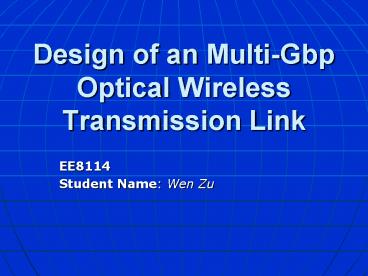Design of an Multi-Gbp Optical Wireless Transmission Link - PowerPoint PPT Presentation
Title: Design of an Multi-Gbp Optical Wireless Transmission Link
1
Design of an Multi-Gbp Optical Wireless
Transmission Link
- EE8114
- Student Name Wen Zu
2
Content
- Selection of wavelength
- System Structure
- Alignment and tracking, Adjustment
- Assumptions and Calculation
- Problems in the next step
- References
3
1. Selection of wavelength1550nm
- Options of wavelength780 nm to 850nm,
1300nm1550nm and 9 micron. - Advantages of using 1550nm
- 50 times more transmitted power at 1550 nm than
800 nm considering the eye safety limit. The eye
safety limit of 1550 nm is 100 mW/cm², comparing
to 20 mW/cm² _at_800nm - Receivers have nearly 3 dB better receiver
sensitivity at 1550nm than 850nm due to the lower
energy per photon.
4
- 3. 1550nm is the most commonly specified
wavelength range for fiber-based optical
communication. The supporting technical base for
this wavelength range is vast and growing rapidly
every year. Therefore, it will be easy to access
new cost-effective technologies to update this
design, and to keep this design on the top
performance.
5
2. Structure
- A five beam system. Four beam are used to
transmit down. One beam is used to transmit up,
and used in Alignment and tracking, Adjustment
systems.
6
- Figure 1. The function parts of this design
7
- Figure 2. The function parts of this design(2)
8
- Figure 3.The working of transmitters and
receivers.
9
3. Alignment and tracking, Adjustment
- Alignment and tracking system is designed to
co-align the transmit and receive optical axes
when settle these devices, and to keep the
alignment of transmitters and receivers in the
future. Buildings could bend, vibrate, or move
slightly in wind or uneven thermal loading, e.g.
sunshine on one side. This system receives
dictations from a micro processor system, and
operate a 2D mechanical structure- servo system.
Figure 5,6 show tracking systems use in CANON
Optical Wireless Communication designs .
10
- Figure 5. Use of Tracking system.
Figure 6. Performance of Tracking system
11
- Adjustment system operates transmit optics to
fulfill the function showing in figure 3
depending on the real weather or BER, and to
maintain an acceptable system performance.
12
4. Assumptions and Calculation
- Assumptions
- Transmitter Laser (1550nm) x 5
- Average Laser Power 1000mw/30dBm
- Transmit Divergence 0.1 mrad(1/e2 )
- Transmit aperture 4cm
- Receiver InGaAs APD (1550nm) x 5
- Receiver Sensitivity -30 dBm
- Receive Aperture 15cm
- Max. Data Rate 1000Mbps x 4
13
- BER 1.00E-12
- Transmit Optics Degradation -1dB
- Receive Optics Attenuation -1dB
- Calculation
- Eye safety
- Transmit power/Transmit area 79.6mw/cm² lt
100 mW/cm² (Eye safety limit _at_1550nm) - Beam spread _at_280m7.9cm lt Receive Aperture 15cm
- Max. link power margin Transmit Power x 4
(36dBm)-Receiver Sensitivit (-30dBm)-Geometric
Range Loss(1)-Transmit Optics Degradation(1)-Recei
ve Optics Attenuation(1)-Filter Loss(1) 62dB
14
- Maximum Range at -220dB/km atmosphere
attenuation. - Figure 3 shows the main atmosphere attenuation -
Mie scattering, varies with wavelengths. The
max. atmosphere attenuation _at_ 1550nm is
-220dB/km, and atmospheric loss is 62dB - Max. Range 281m.
15
Figure 4. Mie scattering attenuation in dB/km
for the various fog distribution models
16
5.Problems in the next step
- Design of transmit optic and receive optic.
- Completing design of alignment and tracking
system - Completing design of adjustment system
17
References
- Z.Ghassemlooy, Optical Wireless Communications -
Our Contribution - J.R. Barry, Wireless Infrared Communication,
Kluwer Academic Press, Boston, 1994, 1st edn. - Chaturi Singh, Y.N.Singh, J.John, K.K.Tripathi,
High-Speed Power-Efficient Optical Wireless
System - Scott Bloom, Seth Hartley, THE LAST-MILE
SOLUTION HYBRID FSO RADIO - Scott Bloom, THE PHYSICS OF FREE-SPACE OPTICS
- Isaac I. Kim, Eric Korevaar, Availability of
Free Space Optics (FSO) and hybrid FSO/RF
systems - Jim Alwan, EYE SAFETY AND WIRELESS OPTICAL
NETWORKS - fSONA Communications Corp. WAVELENGTH SELECTION
FOROPTICAL WIRELESS COMMUNICATIONS SYSTEMS































